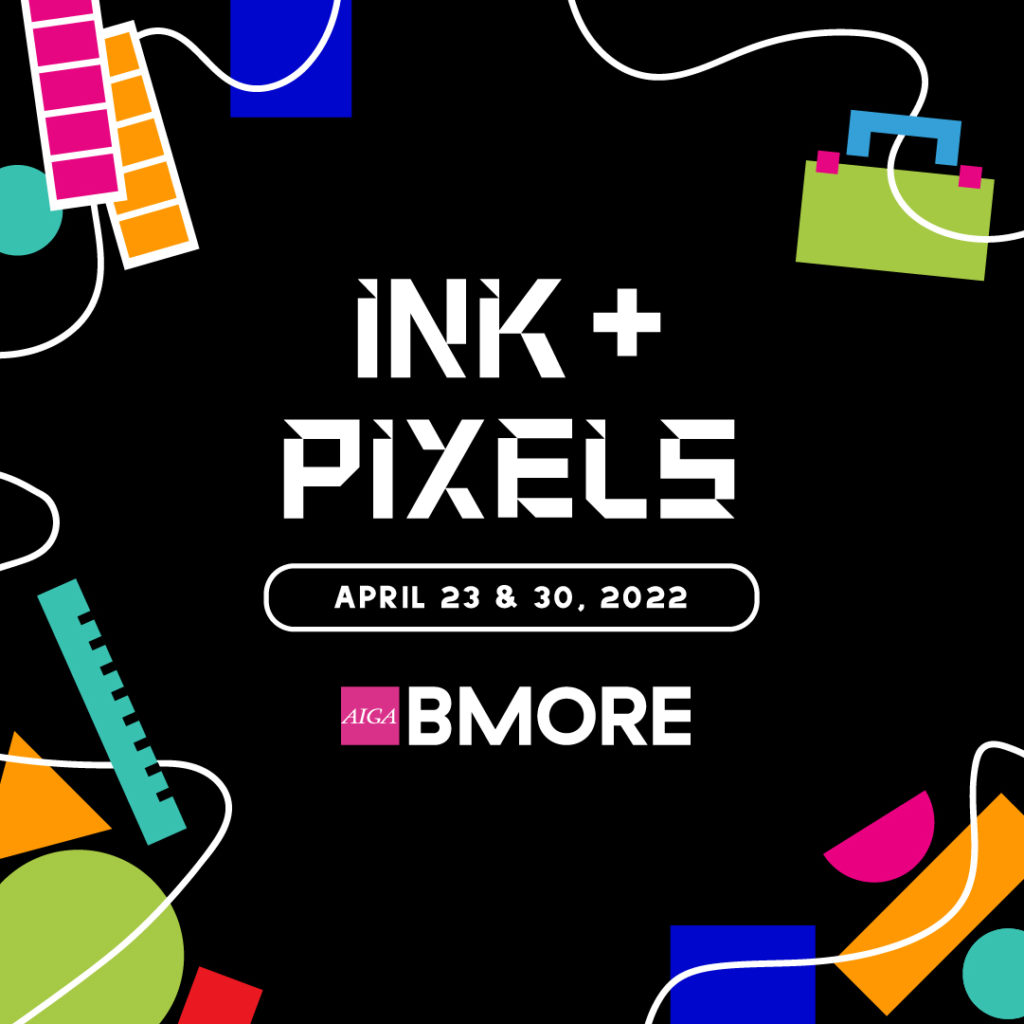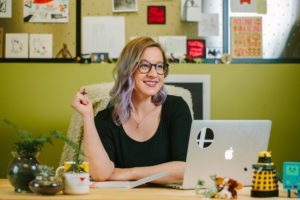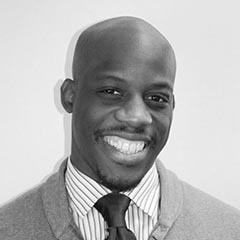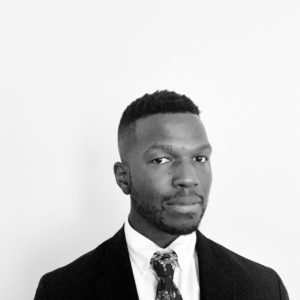Ink & Pixels is coming up at the end of April! Save the dates for the virtual panel, “From Portfolio to Offer: The Art of Getting Hired” on April 23rd and the in-person portfolio reviews on April 30th. This year, the branding for Ink & Pixels was designed by Jamie Wheeler of Jelly Creative Co. (@jellycreativeco) and Jess Langley of White Coffee Creative (@
Can you tell us about yourself? What’s your story?
Jamie — My go-to line is, “I’ve been getting paid to design for almost 15 years.” It started with a high school internship, a design degree from York College of PA, various design jobs, a few years teaching, and now I own Jelly Creative Co. A branding and design studio for the creatively ambitious. I also like lava lamps, Nutella, my dog Nova, reading fiction, and playing board games with my husband. When I’m working towards a deadline you’ll find 90’s hits or EDM blasting on my Spotify.
Jess — My story has been full of lessons and ups and downs. In college, I landed my first design-related job as a Store Artist at Whole Foods. I learned lettering, how to work with others, and built up my confidence. That led to my first internship turned design job after graduating with a BFA in Graphic Design from Towson University. After being laid off from there in June 2017, I decided I was done with the typical 9-5 culture and went out on my own. I started White Coffee Creative and haven’t looked back since! My services, style, branding, and who I like to work with have changed drastically since then but I’m so grateful for the journey. I started coaching creatives in 2020 and now am learning to balance the two businesses with ease. When I’m not working, you can find me sipping coffee (obviously, with extra cream and sugar), bingeing Netflix shows, hiking with my 2 pups and partner, or dreaming about having a cabin in the woods.
How did you meet and start working together?
Jess had been running her business for two years when I DM’d her on Instagram asking if we could meet for coffee and talk shop. We met up at Spoons for breakfast and just clicked! She was my first local design/business owner friend and a huge supporter as I went full-time with my company in 2019. Community is really important to us both so when I brought the idea of a group for local designers to Jess she was on board to help start the Facebook group, Baltimore Graphic Designers, which now has 300 members! We have worked on local branding projects together, drank lots of local coffee, sent countless voice messages, and continue to cheer each other on. After Ink & Pixels, we’re excited to see what design mischief we can get into next!
How did you approach this branding project and what was your design process?
We were inspired by the juxtaposition of ink (organic) and pixels (geometric). We started with basic shapes within the AIGA color palette, then using only these shapes we started creating icons that can be used in various ways. The final touch is the wavy lines that intersect with the shapes and icons to create movement and bring everything together.
Having a stark black background allows the colorful elements to be brought to life and grab your attention while scrolling on Instagram or walking by on campus.
The fonts are designed by our friend Alex of The Routine Creative, a Texas-based designer. The jackknife font just felt too perfect not to highlight!
Can you describe your inspiration and any challenges you came across them while designing the branding?
If we had been working solo, there may have been more challenges, but we were able to pass the files back and forth when one of us was feeling stuck creatively. We have worked on branding projects together so we hopped right back into a nice groove. When we say it was a fun project, we really mean it!
What’s your favorite part about designing branding?
Jamie — Like any large design project there are the peaks and valleys, I think the moments right after the valleys are my favorite. I think all designers have the thoughts of “this is never going to work, what am I doing” but it’s the “oh yeah, this is it!” that I’m always chasing.
Jess — I love pulling visual inspiration and using strategy and color psychology to tie in meaning. It’s always a fun challenge to create branding that visually captures the essence of a business while maintaining simplicity. So that beginning exciting energy and the finale of when it’s all done and ready to show the world are my favorite parts.
Was there an aha moment when you knew you wanted to be a designer?
Jamie — Why yes, yes there was. It was when I photoshopped Ashton Kutcher into my homecoming photo and posted it to my Myspace. Technically, that’s when I opened the world to design, but the moment I learned it was an actual career and a college major I knew that was the path I was taking.
Jess — Yes! In college, I dabbled in a few different majors—journalism, photography, general fine arts, and design. I vividly remember one of my college professors (shoutout to Carolyn Norton!) in an Intro to Design class telling me I was already a designer. Getting that recognition and encouragement made me feel ready to step into this direction as a designer full-heartedly, and I got accepted into the GD program at Towson that following semester!
In the long term, what do you hope to eventually accomplish as a designer? What is your biggest goal/dream as a creative?
Jamie — This question is making me realize how much I have accomplished as a designer already, which is really cool. My dream client at the moment would be to work with a performing arts company. Lately, I’ve been searching for ways to bring all my talents and interests together while also helping other designers and keepin’ it real. A huge dream of mine was to host a retreat for designers, which is happening this spring, so I’m too sure what’s next!
Jess — I’m really enjoying running my own studio. I love being a multi-faceted creative offering design, murals, AND coaching. I hope to continue to navigate balancing a variety of tasks, projects, and clients while continuing to reinvent myself and where I want to go next. My big dreamy goal right now is to speak on stage at a creative conference one day about intentionally finding that balance as a business owner while having the freedom to explore a variety of creative outlets.
Thank you to Jamie and Jess for sharing their stories! We cannot thank you both enough for creating the branding for this year’s Ink & Pixels. Make sure to follow them on their various social channels!
White Coffee Creative
Designer + Muralist
whitecoffeecreative.com | @
The Colorful Jess
Mindset + Pricing Coach
thecolorfuljess.com | @
Jamie Wheeler
Owner + Creative Director
jellycreativeco.com | Instagram | Facebook

 Emilee Beeson, Designer, and Illustrator
Emilee Beeson, Designer, and Illustrator Perry Sweeper, Design Strategist
Perry Sweeper, Design Strategist